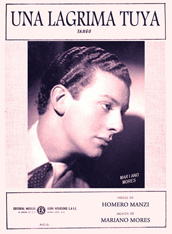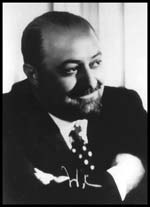By
Una lágrima tuya, story of its creation

he poet Homero Manzi underwent a long disease, aware of the unavoidable ending which took place on May 3, 1951. In an interview with Irene Amuchástegui, Mariano Mores remembered: «One afternoon I went to visit Manzi, when he was already very ill. Chatting, he told me: “I’m departing without having written anything with you, and I blame myself for that. But you, as well... were never able to tell me”. I replied: “Well, it seemed reckless to me, because you always worked with Troilo. And furthermore, what you do has a local flavor and what I do, instead, has not much localism, it has a more universal style”. As he insisted, I asked if there was a piano in the house and made him listen to something I was writing at that time for the movie Corrientes, calle de ensueños. He listened to me from his bedroom and right away he wrote el monstruo (as the rough sketch of the meter is called). Three days later he called to tell me: “I wrote a precious thing”. Then I returned to his place and, it, really, was a total piece».
 According to the date when the movie Corrientes, calle de ensueños was shot (directed by Román Vignoly Barreto), what the composer tells us was happening in 1948. On the Mores’s music theme, which blends tango with airs of malambo and huella —in the same style of country fusions like his previous tango “Adiós pampa mía” and his later tango “El estrellero”, Manzi wrote lyrics loaded with nostalgia of the hills. In fact, not only one, but three versions of the same lyrics.
According to the date when the movie Corrientes, calle de ensueños was shot (directed by Román Vignoly Barreto), what the composer tells us was happening in 1948. On the Mores’s music theme, which blends tango with airs of malambo and huella —in the same style of country fusions like his previous tango “Adiós pampa mía” and his later tango “El estrellero”, Manzi wrote lyrics loaded with nostalgia of the hills. In fact, not only one, but three versions of the same lyrics.
“Una lágrima tuya” was played twice in the movie. Firstly, by Mores himself, who impersonates the main character, and here he sings accompanying himself on piano:
Vive soñando
pero esa blanca estrella
siempre, siempre está lejos.
Por amargos caminos
vuelve el pasado
y por esos caminos
se van los sueños
y de pronto resuena su propio paso
como si fuera el eco
de algún recuerdo.
Una luna que rueda por la montaña
y una lágrima tuya
que moja el alma...
The second rendition is in the final scene, in which Canaro conducts a large orchestra and Enrique Lucero sings, with a choir:
Temblor de ala lejana
trajo tu voz
y una mañana
me dijo adiós.
Rumor de manantial
y el repicar
de las campanas
y un cielo azul
lleno de luz
y un campo verde
lleno de sol.
Una luna que rueda
por la montaña
y una lágrima tuya
que moja el alma.
 This scene, according to the detailed record written by Antonio D'Alessandro, violinist of Canaro, was shot on August 31, 1948, at the Maipo theater.
This scene, according to the detailed record written by Antonio D'Alessandro, violinist of Canaro, was shot on August 31, 1948, at the Maipo theater.
These two excerpts may be regarded, in any case, tentative lines of the lyrics that appear in the recorded rendering by the Aníbal Troilo orchestra with the singers Edmundo Rivero and Aldo Calderón on March 30, 1949 (that is to say, after the shooting but before the premiere of the film), which is the one that lasted in all the later recordings of the tango. It turns out clear that Manzi, after the shooting of the movie, finished to shape the lyrics (those two previous lyrics, next to the transcribed verses have still identical lines to the final version).
The success of “Una lágrima tuya” was immediately after its premiere, made by Troilo on Radio El Mundo (simultaneously with his rendition on record), that is to say, months before the premiere of the movie, on September 29, 1949. Among other recordings of that time, let us mention those of the orchestra led by José Basso with Francisco Fiorentino and Ricardo Ruiz on vocals (made on May 27, 1949), and Francisco Canaro with Mario Alonso (on October 13, that same year). Also at a time close to its premiere, the soloists Charlo and Hugo Del Carril recorded it.
Mores recorded his tango in 1957, with Enrique Lucero (his brother) on vocals and, in 1977 with Nito Mores (his son) on vocals. He also made and instrumental version as ‘tango malambo’ on the theme of “Una lágrima tuya”, in 1960. And he always included it in the repertoires of his successive music lineups.
There are renditions by Libertad Lamarque, Nelly Omar, Enrique Dumas, Rosanna Falasca, Susy Leiva, Alberto Marino and Claudia Mores as a duo, Los Cinco Latinos and Antonio Prieto. As instrumentals, it was committed to record by the José Basso orchestra —who had previously made it with vocals— and by the Banda de la Fuerza Aérea Argentina (The Argentine Air Force Band).
Published in the book: Cien tangos fundamentales, by Oscar del Priore and Irene Amuchástegui, Aguilar, Buenos Aires 1998.